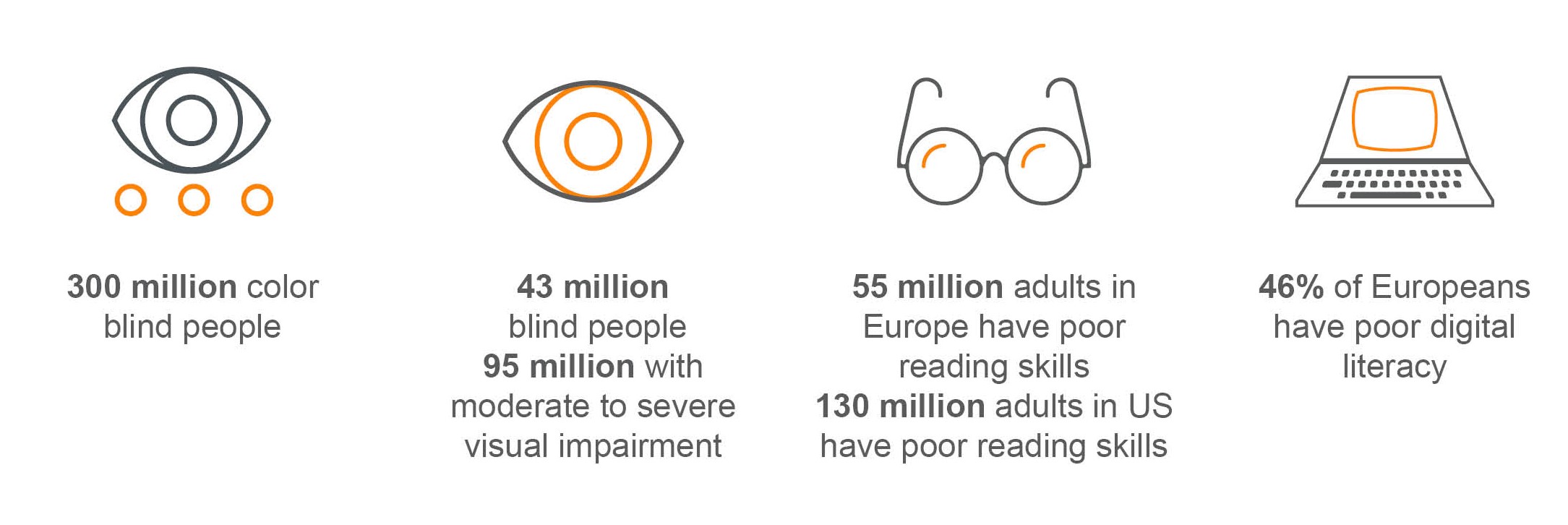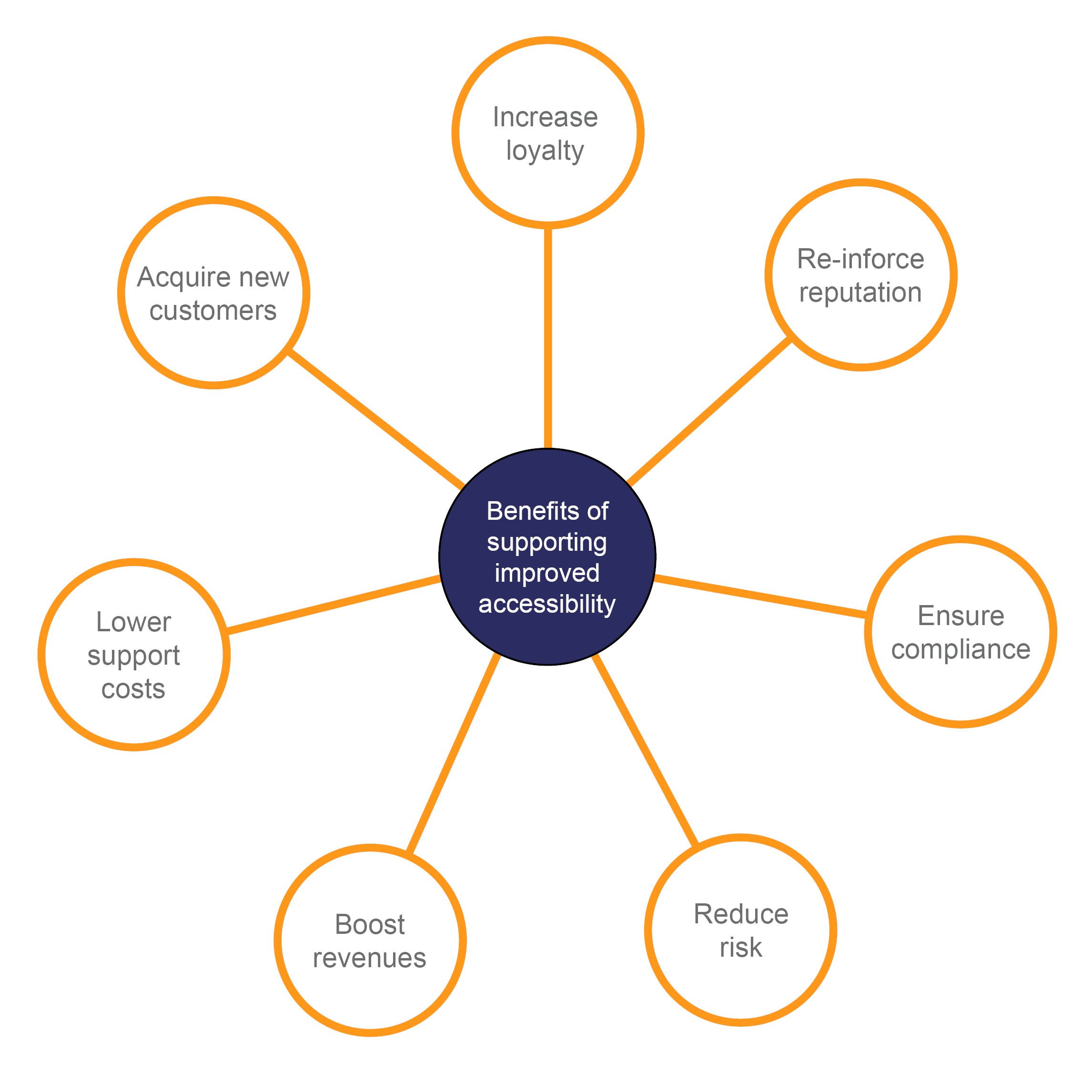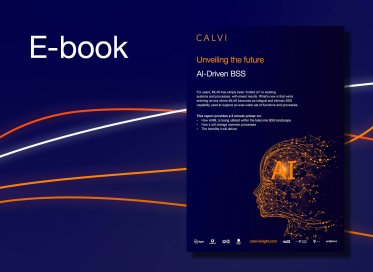Beyond compliance – why accessibility is good for business
1 March 2023
|
Walter Neeft
15% of the global population has some form of disability, including visual, auditory, or cognitive disabilities. In many countries, it’s now a legal requirement to ensure that people with disabilities can access the information they need. As stated by Anacom, Portugal now even mandates telecom companies to ensure equal access for individuals with disabilities, requiring tailored equipment, software and tariffs starting from June 28, 2025, aligning with EU accessibility directives to enhance digital inclusivity and equal opportunities. But supporting accessibility should be motivated by a need for compliance and the desire to ensure all customers have a good digital experience.
What is accessibility, and why should we care?
All customers should be able to access and understand the information provided by their Service Providers through digital channels. This includes every communication read by or sent to customers, such as website content, onboarding or bill notifications, text messages, and in-app notifications.
From a billing perspective, customers must understand what they’re signing up for, what their charges are, and why they have to pay the amount stated on the bill. However some customers have disabilities that affect their digital experience and, thus, their ability to understand key communications such as bills.
- 300 million people worldwide have some degree of color blindness.
- 43 million people are living with blindness worldwide, and 295 million are living with moderate-to-severe visual impairment. People with visual impairments from mild to severe are forecast to increase from 1 billion in 2020 to 1.8 billion people by 2050.
- In Europe, one in five 15-year-olds and around 55 million adults between 15 and 65 years of age have poor reading skills. The US Department of Education estimates 130 million people (56% of 16-74-year-olds) lack proficiency in reading, which they define as a reading level below that of a typical 12-year-old.
- The US Department of Education estimates that 16% of US adults are not digitally literate (32 million Americans). While the EU says, 46% of Europeans have less than basic levels of digital literacy. In Europe, the level varies considerably between countries. While more than 70% of Danes, Finns, and Swedes are considered digitally literate, Bulgaria and Romania reported that less than a third of their populations are digitally literate.

Sources: Colour Blind Awareness, IAPB Vision Atlas, Elinet, National Center for Education Statistics, Eurostat
What’s the legal position?
Most UN Member States and the European Union have committed to ensuring increased digital accessibility, including online access to information, products, and services for those with disabilities.
Ensuring your communications are accessible is not a ‘nice to have’ but essential to ensure a good digital experience for all your customers. The foundation of compliance is adhering to a technology-neutral standard for electronic content – such as the W3C’s Web Accessibility Initiative, WCAG 2.0. Countries around the world now have policies and laws to ensure digital accessibility and non-discrimination – many of which are based on the WCAG 2.0 standard – including Australia, Canada, China, Denmark, Finland, France, Germany, India, Ireland, Israel, Italy, Japan, Netherlands, New Zealand, Norway, Republic of Korea, Sweden, Switzerland, Taiwan, UK, and the US.
Benefits beyond compliance
While accessibility has been mandated in many countries, implementing accessibility initiatives provides many benefits beyond a simple box-ticking exercise. Importantly, in the B2B market, employee experience (EX) is now extremely important, and enterprise customers have their accessibility targets and requirements. Ensuring that all employees can easily understand their bills is, therefore, extremely important in B2B billing and B2C settings.
The benefits of supporting improved accessibility

4 simple things you can do today to make your bill communications easier to understand and more accessible
-
Be consistent and clear in the language you use:The words and terms used in your bill should be easy to understand, non-technical and consistent. Terms should make sense to ordinary people, be the same as those used in your marketing literature and at onboarding, and not be abbreviated simply to fit onto a single line of the bill.
-
Focus on format: Consider the font size, color use, and color contrast you use in your bills. Test your bills to ensure they’re usable for people with visual impairments or cognitive difficulties. There are a few handy tools to help you do this such as a contrast checker, but there’s no substitute for customer feedback. Listen to focus groups and customer feedback and evolve your format accordingly.
-
Get the right channels:Customers prefer communication channels that are easy for them to use. While digital billing has many advantages, some customers may find paper easier. Addressing their needs means ensuring that even when you go digital, you still offer the option of self-print bills. While many customers will find new digital bills easier to understand, don’t forget those with visual impairment and ensure your digital bills are optimized for text-to-speech readers. Going forward, consider how audio channels (such as Amazon Alexa) can be utilized to help you provide balance checks and simple queries for visually impaired customers or those with literacy problems.
-
Make the journey consistent:The mobile app and online portal should be consistent. Words and terms should be established during marketing and onboarding and used consistently throughout. People learn through habit, so you can help them find the information they want by being consistent in your approach.
How Calvi helps you become fully accessible
At Calvi, we’re firm believers in the right to equal access, and, as a result, we’ve built a software solution that’s 100% accessible and fully compliant with WCAG 2.1 guidelines. We’ve have optimized our solution for text-to-speech readers and we continue to monitor new standards and mandates as they emerge to ensure our solution remains fully compliant, ensuring that all customers can read and understand their bills.
Service Providers must ensure compliance with WCAG 2.0, but there are also sound commercial reasons for ensuring that all customers can easily understand and use their bills. Regulations will continue to evolve in this area, creating a moving target. That’s why you need to regularly assess your compliance as you roll out new products and innovate your bills.







